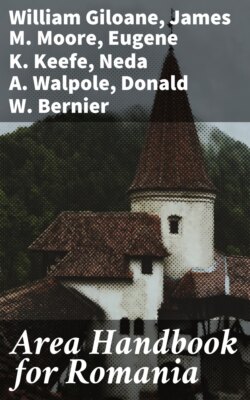Читать книгу Area Handbook for Romania - Eugene K. Keefe - Страница 11
На сайте Литреса книга снята с продажи.
CHAPTER 3 PHYSICAL ENVIRONMENT AND POPULATION
ОглавлениеTable of Contents
Romania, located in southeastern Europe and usually referred to as one of the Balkan states, shares land borders with Bulgaria, Yugoslavia, Hungary, and the Soviet Union and has a shoreline on the Black Sea (see fig. 1). The interior of the country is a broad plateau almost surrounded by mountains, which, in turn, are surrounded, except in the north, by plains. The mountains are not unduly rugged, and their gentle slopes plus the rolling interior plateau and the arc of lowlands on the country's periphery provide an unusually large percentage of arable land.
Romanian historians have remarked that their country's history might have been different had its mountains been located on its borders rather than in the interior. Romania's mountains provided a refuge for indigenous populations but did not constitute barriers against invaders who sought to dominate the area or use it as a crossroad for deeper invasions of the Balkan region (see ch. 2).
The prevailing weather is eastern European continental, with hot, clear summers and cold winters. Rainfall is adequate in all sections, and in normal seasons the greater share falls during the summer months when it is of most benefit to vegetation and crops. Soils on the average are fertile. Forests occupy about 27 percent of the land surface.
All of the major streams drain eventually into the Danube River and to the Black Sea. The entire length of the Danube in or bordering the country is navigable. There are few canals, and the Prut River is the only other waterway that is navigable for any considerable distance. Several of the rivers originating in the Carpathians have a good potential for hydroelectric power but, because oil and natural gas are abundant, their development has not had high priority.
In 1971 railroads carried by far the greatest volume of long-distance freight and passenger traffic, but highway transport was supplanting them in short-haul traffic of both types. Commercial aviation had multiplied its capacities since 1950 but still carried only a minute percentage of total traffic. Pipelines were the principal carriers of liquid petroleum and natural gas. The merchant marine had developed relatively rapidly after 1960 and, although still small, consisted almost entirely of modern ships and equipment.
The population, estimated at more than 20.6 million in 1971, was growing at the second highest rate in Europe. The country's officials, however, did not expect the 1971 rate to be maintained throughout the remainder of the century.
The standard of living was among the lowest in Europe. Living conditions improved markedly after 1950, but emphasis on heavy capital investment held down production of consumer goods. The land has been more than self-sufficient in the agricultural sector, but food products have been exported in quantities that have made some of them scarce locally.
NATURAL FEATURES AND RESOURCES
Topographical and Regional Description
All of the mountains and uplands of the country are part of the Carpathian system. The Carpathian Mountains originate in Czechoslovakia, enter Romania in the north from the Soviet Union, and proceed to curl around the country in a semicircle (see fig. 3). The ranges in the east are referred to as the Moldavian Carpathians; the slightly higher southern ranges are called the Transylvanian Alps; and the more scattered but generally lower ranges in the west are known as the Bihor Massif. A few peaks in the Moldavian Carpathians rise to nearly 7,500 feet, and several in the Transylvanian Alps reach 8,000 feet, but only a few points in the Bihor Massif approach 6,000 feet.
Lowland areas are generally on the periphery of the country—east, south, and west of the mountains. A plateau, higher than the other lowlands but having elevations averaging only about 1,200 feet, occupies an area enclosed by the Carpathian ranges.
Moldavia, in the northeast, constitutes about one-fourth of the country's area. It contains the easternmost ranges of the Carpathians and, between the Siretul and Prut rivers, an area of lower hills and plains. The Moldavian Carpathians have maximum elevations of about 7,500 feet and are the most extensively forested part of the country. The western portion of the mountains contains a range of volcanic origin—the longest of its type in Europe—that is famous for its some 2,000 mineral water springs. Small sections of the hilly country to the northeast also have forests, but most of the lower lands are rolling country, which becomes increasingly flatter in the south. Almost all of the nonforested portions are cultivated.
